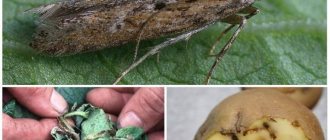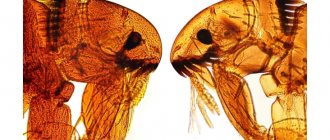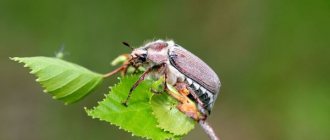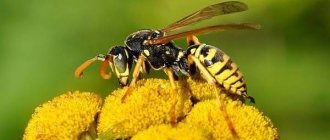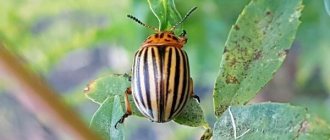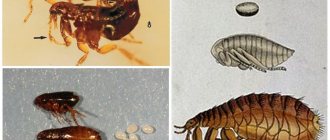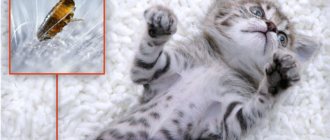Types and size
There are about 2,500 species of fleas in the world that live on animals and birds.
Types of fleas that are more common:
- feline;
- canine;
- human;
- bird;
- rat.
The most common cat flea in the city can also bite people and dogs. The human flea is less common, which is associated with an improved quality of life for people.
The average size of a flea is between 1 and 6 mm. Some types of females after saturation can increase to 1 cm. A fertilized female has a length of up to 15 mm.
The size of the parasite depends on the species. The length of the largest flea reaches 13 mm. This species can be found in North America and only in the habitats of the mountain beaver.
Flea lifestyle
The flea belongs to the order of blood-sucking arthropods. The insect moves by jumping, which can reach 30 cm in height and 50 cm in length. The body of the parasite is flattened laterally and covered with bristles; this structure allows it to move quickly in the animal’s fur. There is a sensory organ on the abdomen that signals the approach of a potential food source and a change in temperature.
Where live
Most often, fleas can be found on dogs and cats, so it may seem that the animals harbor parasites. In reality, warm-blooded animals and humans serve only as a source of food for fleas.
After feeding on blood, the insect jumps off the cat or dog to find a place to breed. In the apartment, parasites live in animal bedding, long-pile carpeting, and the floor. In nature, fleas choose places close to animal habitats. These could be holes, bird nests, garbage dumps, basements.
Flea life cycle, reproduction and development
Stages of flea development.
The life cycle of an insect consists of the following stages:
- Egg.
- Larva.
- Doll.
- An adult, or imago.
The female, after being saturated with blood, which is necessary to reproduce, mates with the male. After fertilization, she lays 4-10 eggs. The eggs are fired over a long distance - this method of laying allows future larvae not to compete for food sources and increases the likelihood of survival.
2 weeks after laying, larvae emerge from the eggs and eat the feces of adult insects, blood residues, and organic matter. At favorable temperature and humidity, the larva can emerge from the egg in 2 days. Before the formation of the pupa, the larva goes through 3 stages of molting. The time it takes for an adult to emerge from a pupa depends on environmental conditions and ranges from 1-2 weeks to 1 year.
Reproduction rate
With good nutrition, fleas multiply quickly: a female can make 2-3 clutches per day, that is, lay up to 30 eggs per day. But more often she has enough strength to make one clutch of eggs. During her life, the female lays up to 500 eggs, after which she dies.
Flea reproduction
Once the flea emerges from the cocoon, it can reproduce. All types of fleas reproduce the same way. Mating can occur both on the body of the breadwinner and outside it.
Fleas have genitals:
- in the female - ovaries, uterus and spermatic receptacle;
- the male has two testes and a genital claw.
The female climbs onto the male's back and takes the genital claw into the spermatheca. The process can take from 30 minutes to 2 hours. Immediately after copulation, the female needs to feed on blood.
The male participates in reproduction once - this is enough for the female to give birth to offspring for the rest of her life, which is at least 400 eggs.
Fleas do not lay eggs in special places, but shoot them out of the abdomen under pressure, thereby expanding the area of distribution. The eggs are not covered with adhesive substances, so they roll freely over the fur and skin without getting stuck anywhere.
Female and male fleas differ in appearance from each other: on the left is a male, on the right is a female
How long do they live?
The lifespan of fleas depends on environmental conditions. Under favorable conditions, some species live up to 18 months. The average life expectancy is about 2-3 months. When the temperature rises to +35 °C, adults and larvae in the cocoon die, their life expectancy does not exceed two weeks.
When the temperature drops to 0 °C, adult individuals die after 5 days. Eggs and larvae will not develop at air temperatures below +13 °C.
Eggs are less sensitive to low temperatures, at which they do not die, but go into suspended animation. The egg can remain in this state for a long period, since the cocoon protects it from dehydration and exposure to low temperatures.
In the laboratory
In laboratory conditions, subject to temperature conditions, humidity and regular provision of a food source to insects, the lifespan of a flea is 5-6 months.
On an animal
The lifespan of a parasite on an animal depends on its self-care skills. The likelihood of lingering on the fur of a young animal is higher than on an adult animal. This is due to good immunity, structural features of the skin and hair, and better hygiene skills in an older animal. After a week, the cat or dog destroys half of the insects that have fallen on the animal’s body. After 3 weeks, 90% of the parasites are destroyed.
Life expectancy without food
In the absence of a regular food source, an adult can live 2-3 months. The parasite needs food for reproduction; while maintaining their activity, they cannot increase their offspring.
Lifespan of fleas
The average lifespan of a parasite is 3–4 months. But everything depends on external conditions:
- air humidity;
- air temperature;
- availability of food.
If fleas are infested in an apartment where there is no control over them or pets, the lifespan is not reduced. In the absence of animals, fleas do not disdain human blood, even if they are representatives of the dog and cat families. In addition, parasitism on dogs and cats, on the contrary, is more dangerous for them - animals have instinctive cleanliness and kill parasites by gnawing with their fangs and combing.
Animals have an instinct for cleanliness and chew and comb out fleas
Fleas can live without food for 4–5 months. They do not slow down their development, but they stop producing offspring. However, cat fleas are known for discarding insects that starve to death within 12 hours (males) and 96 hours (females).
The survival rate of insects also depends on a number of accidents:
- according to statistics, less than half of the eggs laid by one insect survive the full cycle of transformation;
- some eggs and adult insects can be eaten by the breadwinner;
- Eggs are laid at any time of the day and at any moment. Therefore, they can find themselves either indoors and warm, or on a cold frosty street where it is impossible to survive. If the eggs end up in a place where the future larva has nothing to feed on and a lot of sunlight, then the insect also has no chance of surviving.
Long-lived fleas
The longest life expectancy is that of the Tien Shan flea, which parasitizes wild animals living in the northern regions. The average lifespan of this species is about 1 year. During the cold season, the flea's vital processes slow down; in this state, it can live up to 14-16 months. When comfortable conditions arise, the insect returns to active life.
Developmental cycle of the human flea.
Fertilization and egg release
The female genital organs of female fleas are represented by 2 ovaries and 2 short oviducts, which pass into the uterus and the spermatic receptacle (vagina), which has 2 accessory glands.
The male genital organs consist of 2 testes, 2 vas deferens, turning into a single ejaculatory canal, ending in a complex copulatory organ (genital claw).
During fertilization, the male flea holds the female with chitinized teeth collected in ridges, called ctenidia, located in the lower part of the head. The mating process lasts from 15 minutes to several hours. Depending on the conditions, the development of eggs takes from 2 to 14 days. For maximum reproduction, the female needs adequate nutrition, but if the insect is forced to starve, egg development does not occur.
A well-fed female begins to lay eggs within 2-4 hours, firing them forcefully into the environment. Laying occurs in portions - 3-15 pieces. In one clutch, the female can lay from 20 to 35 eggs.
Since the eggs are not attached to the cat's fur, but fall wherever they may, it is not so easy to detect them. In appearance, these are small (about 0.2-0.5 mm in length) white oval grains (when viewed under a microscope, they resemble grains of rice). When they fall to the ground, they get stuck in dust, litter, floor crevices and other conditions favorable for further development.
When the ambient temperature is between 18-25°C, cat fleas are able to reproduce all year round.
What diseases do fleas carry?
All types of fleas can be carriers of infectious diseases.
The most common infections include:
- plague;
- yersinosis;
- pseudotuberculosis;
- typhus;
- salmonellosis;
- tularemia.
Pathogens enter the human bloodstream through saliva when bitten. The rat flea is the most common carrier of infection, as it parasitizes rats, which spread diseases.
Laying eggs of pests
In order to understand how fleas lay eggs, you should consider the actions of the female. In fact, she shoots them into the fur through her abdomen over quite long distances, so she makes sure that as many eggs as possible survive. Scattered over a large area, the larvae can hatch fully and not compete with each other in terms of nutrition.
Parasites go through all stages of transformation:
- egg;
- flea larva;
- insect pupa;
- imago.
Folk remedies for fighting fleas are discussed in the following video:
The larvae hatch in approximately 3–14 days. The next stage of development begins, fleas multiply quickly under favorable conditions: high temperature, high humidity make it possible for the larva to hatch in literally 2-3 days. She begins to feed on dried blood, as well as the feces of adult fleas. Several more processes follow:
- molting (3 times);
- pupation;
- exit from the cocoon.
The duration of the last period also depends on external factors and ranges from several weeks to several months under favorable conditions. As for the unfavorable ones, a flea can stay in a cocoon even for a year , and it is already able to recognize the smell of blood.
Tips from the video will tell you how to deal with fleas in an apartment:
How they bite
Flea bites.
When a flea comes into contact with the skin, it makes a puncture on it. Since it does not have a proboscis, in order to get to the blood vessel, the insect spreads the skin and penetrates deep into the skin.
After a bite, saliva enters the wound, which contains substances that prevent blood clotting. At the moment of a bite, an animal or person feels a sharp pain, after which a small wound appears on the skin with redness around it.
Anatomy of a parasite
The male individual has two testes, which end in a claw (genital claw), which is where the seminal fluid flows. The anatomy of the female is a little more complicated. In addition to one or two pairs of ovaries, the female has oviducts at the junction of the uterus. The mating process is quite long. In order for fertilization to occur, the female climbs onto the male and literally sucks the partner’s genital claw, which is located on his back.
The process of absorption of seminal fluid into the female’s body takes approximately 15 minutes, and mating itself can last up to several hours.
Mating is accompanied by the laying of eggs. The female lays a small amount, about 5-10 at a time. Laying is impossible when the insect is hungry. If she is full, it is likely that she will be able to put off several batches during the day. It should be noted that throughout its life this insect can lay up to 500 eggs.
Certain conditions are necessary for the development of larvae. Usually, a large number of them can be seen in domestic animals , so the appearance and reproduction of fleas in the house is not surprising, because the fur of pets is one of the most favorable places for the development of insects.
How to fight fleas in an apartment, watch the video:
Ways to fight
First you need to find the source of the parasites. If these are pets, then the wool should be treated. If insects have entered from the basement, then it is necessary to seal all visible cracks in the floor and walls and treat the room with insecticidal agents.
Chemicals
The chemicals that make up flea products act on their nervous system, blocking the transmission of nerve impulses, after which paralysis and death of the parasite occurs.
For home disinfestation, products in the form of an aerosol, powder or chalk are suitable . During treatment, it is necessary to evacuate people and animals living in the premises. After measures to destroy parasites, ventilation and wet cleaning are carried out.
Flea remedy “Kombat Super Spray”.
Room treatment products:
- “Combat Super Spray”. The product is available in the form of a spray that contains imiprotrin and cefenothrin as active ingredients. The spray has a low level of toxicity, but can cause poisoning in animals and children. The aromatic additives included in the composition eliminate the unpleasant odor of insecticides.
- "Clean house". The insecticide is available in spray and powder form and contains tetramethrin and cypermethrin. The spray is sprayed in areas where fleas are expected to live; it has a toxic effect only on adult fleas, but does not destroy their eggs. The powder should be diluted with water before use. Using a spray bottle, treat surfaces in the house with the resulting solution.
- "Executioner". An insecticidal agent whose action is due to the substance fenthion. Fenthion, when sprayed, enters the respiratory tract of the parasite and kills it.
Animal treatment products:
- Entomozan. Antiparasitic agent containing cypermethrin 10%. The product is suitable for treating the hair of domestic and farm animals.
- Stronghold. The product is used to kill fleas and prevent re-infection. The active substance selamectin blocks the activity of nerve cells of parasites and leads to their death. The drug is applied topically to the animal’s skin in the withers area.
- Comfortis. Available in the form of tablets for oral administration. The active substance spinosad, entering the parasite's body with food, causes paralysis of its nervous system and death.
Comfortis flea repellent for animals.
Traditional methods
Folk remedies for killing fleas are not as effective as preparations based on chemical compounds, but in situations where it is not possible to use chemicals, you can use folk methods of getting rid of parasites:
- Impact of temperatures. In winter, you can leave your apartment with the windows open for a day to create a negative temperature in the room. In summer, bedding and items with long pile can be hung in the open sun for 2 days.
- The smell of wormwood or tansy. In places where insects are expected to be located, you can lay out herbs, the pungent odor of which is unpleasant for fleas.
- Treating carpets with salt. When salt comes into contact with the integumentary membrane of the parasite, it becomes dehydrated and dies. Salt must be sprinkled onto the carpet, rubbing it to the base of the pile. Leave the carpet in this form for 3 days and then vacuum it.
How to kill flea larvae?
A person in whose home this parasite has appeared should know that the most effective method of control is the use of chemicals (Tetrix, Carbofox), but they are used if the pest has multiplied in large numbers and there is no other way out.
In any other case, the larvae of cat, earth and other parasites die from less radical effects. For example, it is enough to shake out once a week, wash the backing in the area where pets hibernate, treat carpets and soft furniture surfaces with a soda solution (a spoonful of soda per liter of water), and then spray it using a spray bottle. The larvae do not die from soda, but they become weak, so it is easy to shake them out, since they hold on weakly.
They will not be able to hide in a timely manner if the carpet, bedspread, or bedding with them is taken out into the sun, so they quickly die. You can get rid of the larvae of cat, earthen, and dog pests by freezing them out, since low temperatures lead to the cessation of vital activity and then the freezing of the pests. Since the larvae feed on various decomposition products, feces, you can get rid of them by maintaining cleanliness in living quarters and storerooms. That is, in this case, sedentary larvae die from lack of food.
How to get rid of flea larvae - remedies and folk methods
People often ask the question of how to get rid of flea larvae in cats and dogs. But you need to know that all varieties of this pest do not lay their offspring on the body of animals, this applies to cats and any other parasites, since sedentary worms are easy to identify and kill. Therefore, they have to live in animal bedding, in their booths, and other shelters.
This complicates the task of finding them; at the same time, wash animal bedding quite often and pour boiling water over it, since this procedure quickly kills parasites in the early stages of development. Brooms from wormwood and tansy affect cat, dog and other parasites - neither the adult parasite nor its offspring like the smell of these plants.
Low or high temperature also negatively affects the parasite at any age. So carpets, bedding, infected chairs, where the cat likes to sleep, can be taken out into the cold or on a hot day in the sun, where the weakened worms (this is what pests look like during that period of development) will die if the treatment is prolonged, since the environment in any of given situations will be critically unfriendly to them.
Pests at any stage of development quickly die when housing is treated with a steam generator. Today this is the most effective method, but only organizations that professionally remove insects have such equipment.
Therefore, most often removal is performed with chemicals. To do this, all actions are performed in this order:
1. Treatment should begin with the animal, for which use Mr. shampoos. Bruno, Celandine, Hartz, Frontline sprays, so-called drops on the withers Stronghold, Advantage, the head is treated precisely in the indicated part, because not a single animal can reach there with its tongue, which means it won’t get poisoned;
2. The room is treated with a product such as Tetrix; it can also remove any other insect living in the apartment, for example, a bedbug. One of the most popular drugs is Carbofox, pests simply die from it, and it itself is inexpensive, so it is available to everyone.
At what temperature do fleas and their larvae die?
These parasites of all varieties and at various stages of development die if the temperature drops below -15°C; when the temperature is -10°C, they stop reproducing. If the temperature reaches 45°C, then there will be another extreme - insects die from the heat. And this temperature is guaranteed to happen when washing at maximum settings, when boiling, treating with boiling water, pests die and when using a steam generator. This temperature can also occur on a hot day in direct sunlight.
Do flea larvae bite?
This pest, in the early stages of development, cannot feed on the blood of humans or animals. He lives on them only by accident due to the sluggishness of the female who laid her eggs there. In such cases, the parasites most often die and, accordingly, cannot bite a person.
Comprehensive measures
To get rid of annoying insects efficiently, you need to be very careful and careful. There are a huge number of means - from modern to traditional methods. The most important thing is your desire to get rid of annoying pests. To remove fleas you need:
- Carefully inspect and treat with insecticide all surfaces of the house or apartment, bowls and places where animals sleep;
- Keep animals and children away from treated areas;
- In addition to all places in the house, treat the animal with a special product;
- Carry out weekly wet cleaning;
- Repeat the flea extermination procedure several times.
It is worth noting that the larvae are not direct pests. Despite this, it is necessary to get rid of them in order to avoid the appearance of adult individuals. They can be destroyed with the same drugs that are used to poison fleas. Larvae are even more difficult to remove than adult fleas, and you need to be especially careful and thorough in this matter. There is no reason to try to remove larvae using natural means that can scare them away at most. These include thyme, wormwood and eucalyptus. The insects will simply develop resistance, and all efforts will be in vain.
It is necessary not only to get rid of fleas, but also to subsequently maintain the premises in a condition in which they will not attract them. To do this, it is worth maintaining cleanliness and order, purchasing flea collars for animals that spend time outside, and constantly monitoring the condition of rugs and bedding.
